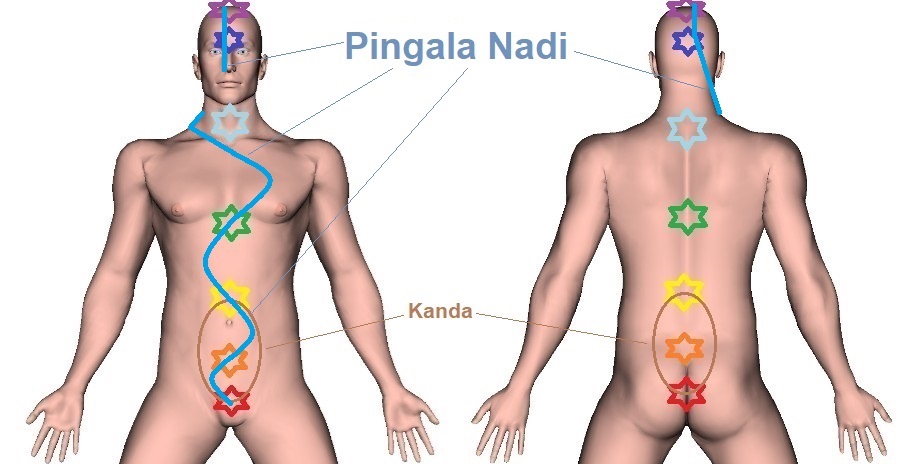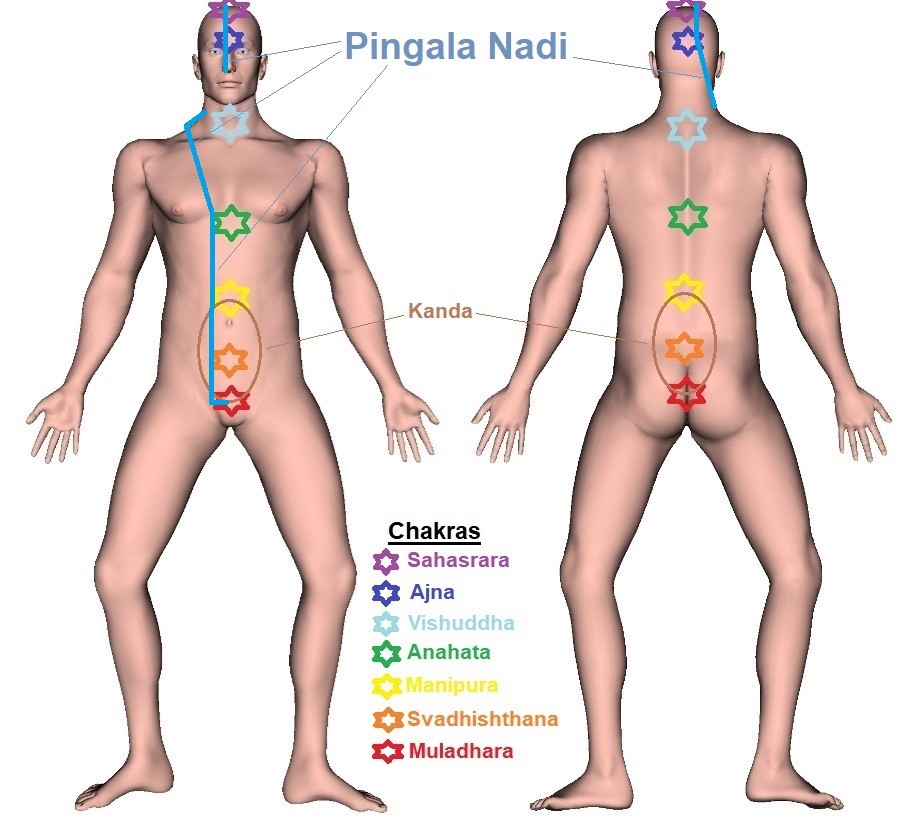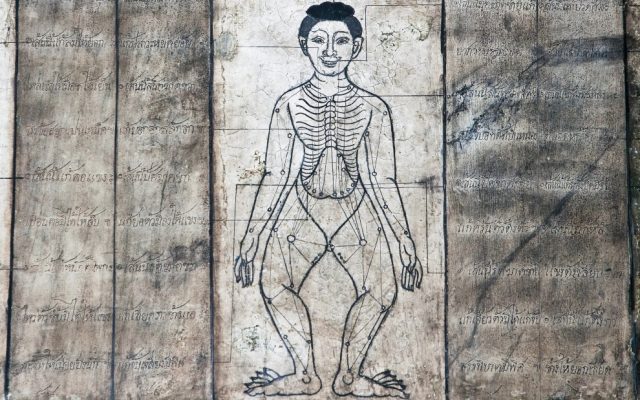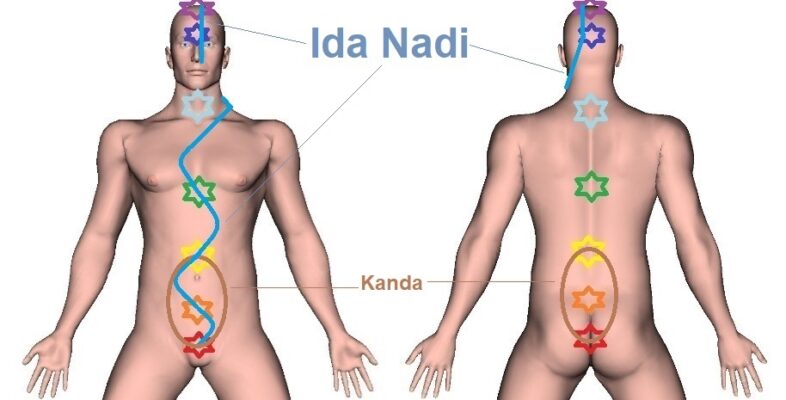
Pingala Nadi, also known as Surya Nadi (Sun Channel or Solar Channel), is the Prana Energy Channel located at the right side of Sushumna Nadi, and is one of the fourteen major Nadis in Yoga.

It’s also one of the three principal Nadis, that is, the trinity of Sushumna, Ida and Pingala Nadi, the so-called Trividha Nadis.
Other names used for Pingala Nadi are Pingalika, Dumbhini, Yamina, Yamuna, Aksara, Kalagni, Rudri, Mihira, and Candi Nadi.
Pingala Nadi represents masculine, sunny, hot, active energy, and is the mirroring but complementary channel of Ida Nadi, the latter being the left-side Energy Channel when compared to the position of Sushumna Nadi.
It’s generally agreed on that Pingala represents the “right breath,” that is, breath flowing in and out of the right nostril, although some ancient Yoga texts (even if rare) assert that Pingala embodies the left nostril.
Location and Trajectory of Pingala Nadi


As with the other principal Nadis, it would be speculation to precisely affirm its location and trajectory in the body, because many scriptures merely supply starting, intermediary, and/or ending points of the Nadis.

Nevertheless, many classical Yoga texts state that Pingala Nadi runs primarily on the right side, parallel to Sushumna Nadi. As such, there’s relative certainty about the pathway Pingala Nadi takes.
Additionally, an interesting comparison could be made with the Thai Energy Line Sen Pingkhala, the equivalent and derivative of Pingala Nadi in Thai Massage (and in Thai Traditional Medicine in general).
Tentatively, we’ve displayed two images above with two different pathways (two options) for Pingala Nadi. Please, do mind that these are just examples of many possible interpretations.
Chart Option 1 shows the Nadi going straight up from the Kanda (the purported start of all the Nadis) along the spine, which then (after the fourth Chakra — Anahata Heart Chakra) crosses the right shoulder and goes over the head to the right nostril.
Chart Option 2 starts in the Kanda and then circles (spirals like a helix) around Sushumna Nadi and intersects with Ida Nadi at the Chakras, which then (after the fourth Chakra — Anahata Heart Chakra) crosses the right shoulder and goes over the head to the right nostril.
Some assert that Pingala Nadi traverses all seven — or at least six Chakras up to the Ajna Chakra (Third Eye Chakra) before proceeding to the right nostril. In these versions of the presumed pathway, Pingala Nadi doesn’t diverge to the back of the body, but rather stays at the front.
In any case, one finds several trajectories and locations described in ancient Yoga sources, such as:
- Pingala stands on the right of Susumna (Darshana Upanishad);
- Pingala extends up to the right nostril (Darshana Upanishad);
- Ida is on the left side and Pingala on the right side, while the Susumna is in the middle. These three are known to be the paths of Prana (Dhyana Bindu Upanishad);
- The Nadi standing on the left of Susumna is Ida. The Nadi standing on the right of Susumna is Pingala (Dhyana Bindu Upanishad);
- Ida and Pingala conduct through the nostrils (Siddha Siddhanta Paddhati);
- Pingala Nadi which is the protector on the right side (Kshurika Upanishad);
- There on the left is Ida, the moon-nerve; on the right is Pingala, the sun-nerve (Saubhagya Lakshmi Upanishad);
On the left of Susumna is situated Ida and on the right is Pingala. The moon moves in Ida and the sun in Pingala (Shandilya Upanishad); - Pingala goes upwards to the right nostril (Shandilya Upanishad);
- Ida is on the left and Pingala on the right [of Susumna] (Yoga Shikha Upanishad);
- Ida and Pingala stand on the left and the right side of Susumna respectively (Yoga Chudamani Upanishad);
- Nadis Ida and Pingala stand at the left and right of Susumna. Ida originates from the navel and terminates at the left nostril and Pingala with the same origin terminates at the right nostril (Tri Sikhi Brahmana Upanishad);
- There are two nerve currents, Ida and Pingala, along the spinal column and a hollow canal, Susumna, in the middle (Hamsa Upanishad);
- The right side vessel, which is Pingala, is another form of the sun, and the giver of Nirvana (Shiva Samhita);
- The Nadi called Pingala is on the right side; coiling around the central vessel (Sushumna), it enters the left nostril (Shiva Samhita);
- The Pingala also comes in the same way from the left side portion of the Ajna lotus, and goes to the right nostril, and has been called by us the Asi (Shiva Samhita);
- Pingala is located on the right side (Goraksha Samhita);
- Nadis located at the left and right are known as Tamasa and Rajasa respectively. Ida is of the nature of moon and Pingala is of the nature of sun (Hatha Ratnavali);
- Pingala is on the right of the Sushumna and extends up to the tip of the nose on the right side (Yoga Yajnavalkya);
- Ida and Pingala are to its [Susumna] left and right. Ida is situated on the left and Pingala on right side (Vasistha Samhita);
- Pingala is occupying the right side and going upwards up to right nostril (Vasistha Samhita );
- In time by the action of Vayu a straight long Nadi called Sushumna is produced. The mouth of the Nadi is downwards. There is a Nadi on each side of it. That on the left is Ida and that on the right is Pingala (Prapanchasara Tantra);
- Pingala, connected with the right scrotum, encircles Sushumna, passes by the left hip, goes to the heart-and thence passing by the right shoulder proceeds to the left nostril (Prapanchasara Tantra);
- Ida is situated on the left, Pingala on the right and Susumna in the middle (Shiva Swarodaya);
- Pingala, to Svabhavandanatha, on the right nostril (Bhavana Upanishad);
- Ida and Pingala in which moon and sun continuously turn, originate from the core of Kanda and course through left and right sides respectively of Susumna (Hatha Tattva Kaumudi);
- Hail to the left part of the forehead, Pingala, the Sakti made of Mantra (Bhavana Upanishad).
Functions of Pingala Nadi
Pingala Nadi is said to stimulate body heat, perception, confidence, reasoning, rationality, discrimination, efficiency, strength, vigor, analysis, and creativity, that is, it governs vital processes in the body.

It’s also thought that Pingala regulates the entire right side of the body. To control Pingala, one needs to manipulate the breath through the right nostril.
It’s also thought that Pingala Nadi can control the Sympathetic Nervous System (SNS), which is part of the Autonomic Nervous System (ANS). The SNS is considered to be responsible for the autonomous “fight or flight” stress and challenge response. In those situations, the SNS tends to speed up one’s heart rate, deliver more blood to areas of the body that need more oxygen, or triggers other responses that help to face difficult or dangerous situations.
A particularity of Pingala Nadi is that it seems to be connected with the right testicle in men. Additionally, Pingala is associated with the color red and stands symbolically for the sun qualities.















